Channel Migration of the Meandering River Fan: A Case Study of the Okavango Delta
Abstract
:1. Introduction
2. Study Area
3. Materials Methods and Terminology
4. Results
4.1. Geomorphological Migration Characteristics and Models
4.2. Expansion Model
4.3. Contraction Model
4.4. Compound Migration
5. Discussion
5.1. Application of River Reconstruction
5.2. Spatial Distribution of Migration Models in the Okavango DFS
5.3. Implications for Meandering River Fan Models
6. Conclusions
Author Contributions
Funding
Institutional Review Board Statement
Informed Consent Statement
Data Availability Statement
Conflicts of Interest
References
- Deb, M.; Das, D.; Uddin, M. Evaluation of meandering characteristics using RS & GIS of Manu River. J. Water Resour. Prot. 2012, 4, 163–171. [Google Scholar]
- Boothroyd, R.J.; Williams, R.D.; Hoey, T.B.; Barrett, B.; Prasojo, O.A. Applications of Google Earth Engine in fluvial geomorphology for detecting river channel change. Wiley Interdiscip. Rev. Water 2020, 8, e21496. [Google Scholar] [CrossRef]
- Weissmann, G.S.; Hartley, A.J.; Scuderi, L.A.; Nichols, G.J.; Owen, A.; Wright, S.; Felicia, A.L.; Holland, F.; Anaya, F.M.L. Fluvial geomorphic elements in modern sedimentary basins and their potential preservation in the rock record: A review. Geomorphology 2015, 250, 187–219. [Google Scholar] [CrossRef] [Green Version]
- Rowland, J.C.; Shelef, E.; Pope, P.A.; Muss, J.; Gangodagamage, C.; Brumby, S.P.; Wilson, C.J. A morphology independent methodology for quantifying plan view river change and characteristics from remotely sensed imagery. Remote Sens. Environ. 2016, 184, 212–228. [Google Scholar] [CrossRef] [Green Version]
- Leopold, L.B.; Bagnold, R.A.; Wolman, M.G.; Brush, L.M. Flow Resistance in Sinuous or Irregular Channels: Professional Paper 282-D; Government Printing Office: Washington, DC, USA, 1960.
- Leopold, L.B.; Maddock, T., Jr. The Hydraulic Geometry of Stream Channels and Some Physiographic Implications: Professional Paper 252; Government Printing Office: Washington, DC, USA, 1953.
- Leopold, L.B.; Wolman, M.G. River Channel Patterns: Braided, Meandering, and Straight: Professional Paper 282-B; Government Printing Office: Washington, DC, USA, 1957.
- Wolman, M.G.; Miller, J.P. Magnitude and frequency of forces in geomorphic processes. J. Geol. 1960, 68, 54–74. [Google Scholar] [CrossRef] [Green Version]
- Brice, J.C. Evolution of meander loops. GSA Bull. 1974, 85, 581–586. [Google Scholar] [CrossRef]
- Hooke, J.M. Changes in river meanders: A review of techniques and results of analyses. Prog. Phys. Geogr. 1984, 8, 47–508. [Google Scholar] [CrossRef]
- Hooker, J.M. Processes of channel planform change on meandering channels in the UK. In Changing River Channels; Gurnell, A., Petts, G.E., Eds.; John Wiley and Sons: Chichester, UK, 1995; pp. 87–115. [Google Scholar]
- Weissmann, G.S.; Hartley, A.J.; Nichols, G.J.; Scuderi, L.A.; Olson, M.; Buehler, H.; Banteah, R. Fluvial form in modern continental sedimentary basins: Distributive fluvial systems. Geology 2010, 38, 39–42. [Google Scholar] [CrossRef]
- Hartley, A.J.; Weissmann, G.S.; Nichols, G.J.; Warwick, G.L. Large distributive fluvial fystems: Characteristics, distribution, and controls on development. J. Sediment. Res. 2016, 80, 167–183. [Google Scholar] [CrossRef]
- Davidson, S.K.; Hartley, A.J.; Weissmann, G.S.; Nichols, G.J.; Scuderi, L.A. Geomorphic elements on modern distributive fluvial systems. Geomorphology 2013, 180, 82–95. [Google Scholar] [CrossRef]
- Blum, M.; Martin, J.; Milliken, K.; Garvin, M. Paleovalley systems: Insights from quaternary analogs and experiments. Earth-Sci. Rev. 2013, 116, 128–169. [Google Scholar] [CrossRef]
- Shan, J.; Ji, Z.; Zhao, Z.; Li, F.; Sun, L.; Zhang, B.; Fang, S. Analysis of sedimentary and evolution process for underground meandering river point bar: A case study from No. 23 thin layer of Yangdachengzi oil reservoir in Jilin oilfield. Acta Pet. Sin. 2015, 36, 809–819. [Google Scholar]
- Schuurman, F.; Kleinhans, M.G.; Middelkoop, H. Network response to disturbances in large sand-bed braided rivers. Earth Surf. Dyn. 2016, 4, 25–45. [Google Scholar] [CrossRef] [Green Version]
- Elina, K.; Leena, L.; Eliisa, L.; Petteri, A. Flow patterns and morpho-logical changes in a sandy meander bend during a flood: Spatially and temporally intensive ADCP measurement approach. Water 2017, 9, 106. [Google Scholar]
- Lin, Z.P.; Shan, J.F.; Chen, L. Geomorphology processes of channel planform migration on meandering rivers. Acta Geol. Sin. 2017, 91, 134–135. [Google Scholar] [CrossRef] [Green Version]
- Lin, Z. Migration structures of meandering channels. Int. J. Inf. Res. Rev. 2017, 6, 4213–4221. [Google Scholar]
- Li, Y.; Zhang, J.L.; Xu, Y.H.; Chen, T.; Liu, J.S. Improved understanding of the origin and accumulation of hydrocarbons from multiple source rocks in the Lishui Sag: Insights from statistical methods, gold tube pyrolysis and basin modeling. Mar. Pet. Geol. 2021, 134, 105361. [Google Scholar] [CrossRef]
- McCarthy, T.S.; Barry, M.; Bloem, A.; Ellery, W.N.; Heister, H.; Merry, C.L.; Röther, H.; Sternberg, H. The gradient of the Okavango fan, Botswana, and its sedimentological and tectonic implications. J. Afr. Earth Sci. 1997, 24, 65–78. [Google Scholar] [CrossRef]
- Wilson, B.H.; Dincer, T. An introduction to the hydrology and hydrography of the Okavango Delta. In Proceedings of the Symposium on the Okavango Delta and Its Future Utilization; Botswana Society: Gaborone, Botswana, 1976; pp. 33–48. [Google Scholar]
- Tooth, S.; McCarthy, T.S. Controls on the transition from meandering to straight channels in the wetlands of the Okavango Delta, Botswana. Earth Surf. Process. Landf. 2004, 29, 1627–1649. [Google Scholar] [CrossRef]
- Stanistreet, I.G.; McCarthy, T.S. The Okavango Fan and the classification of subaerial fan systems. Sediment. Geol. 1993, 85, 115–133. [Google Scholar] [CrossRef]
- Stanistreet, I.G.; Cairncross, B.; McCarthy, T.S. Low sinuosity and meandering bedload rivers of the Okavango Fan—Channel confinement by vegetated levees without fine sediment. Sediment. Geol. 1993, 85, 135–156. [Google Scholar] [CrossRef]
- McCarthy, T.S.; Ellery, W.N. The Okavango Delta. Trans. R. Soc. S. Afr. 1998, 53, 157–182. [Google Scholar] [CrossRef]
- Gumbricht, T.; McCarthy, J.; McCarthy, T.S. Channels, wetlands and islands in the Okavango Delta, Botswana, and their relation to hydrological and sedimentological processes. Earth Surf. Process. Landf. 2010, 29, 15–29. [Google Scholar] [CrossRef]
- Murray-Hudson, M.; Combs, F.; Wolski, P.; Brown, M.T. A vegetation-based hierarchical classification for seasonally pulsed floodplains in the Okavango Delta, Botswana. Afr. J. Aquat. Sci. 2011, 36, 223–234. [Google Scholar] [CrossRef]
- McCarthy, T.S.; Stanistreet, I.G.; Cairncross, B. The sedimentary dynamics of active fluvial channels on the Okavango fan, Botswana. Sedimentology 1991, 38, 471–487. [Google Scholar] [CrossRef]
- Fryirs, K.A.; Ralph, T.J.; Larkin, Z.T.; Tooth, S.; Humphries, M.; McCarthy, T.; Hesse, P.P.; Mosimanyana, E. A nested hierarchical perspective to enhance interpretations and communication in fluvial geomorphology for use in water resources management: Lessons from the Okavango Delta, Botswana. Geogr. J. 2018, 184, 192–207. [Google Scholar] [CrossRef] [Green Version]
- McCarthy, T.S.; Ellery, W.N.; Stanistreet, I.G. Avulsion mechanisms on the Okavango fan, Botswana: The control of a fluvial system by vegetation. Sedimentology 1992, 39, 779–795. [Google Scholar] [CrossRef]
- Jackson, R.G. Depositional model of point bars in the lower Wabash River. J. Sed. Petrol. 1976, 46, 579–594. [Google Scholar]
- Smith, D.G.; Hubbard, S.M.; Lavigne, J.R.; Leckie, D.A.; Fustic, M. Stratigraphy of counter-point-bar and eddy-accretion deposits in low-energy meander belts of the Peace-Athabasca Delta, northeast Alberta, Canada. In From River to Rock Record: The Preservation of Fluvial Sediments and Their Subsequent Interpretation; Davidson, S., Leleu, S., North, C.P., Eds.; SEPM Special Publication: Broken Arrow, OK, USA, 2011; Volume 97, pp. 143–152. [Google Scholar]
- Ielpi, A.; Ghinassi, M. Planform architecture, stratigraphic signature and morphodynamics of an exhumed Jurassic meander plain (Scale-by Formation, Yorkshire, UK). Sedimentology 2014, 61, 1923–1960. [Google Scholar] [CrossRef]
- Lin, Z.P.; Shan, J.F.; Chen, L.; Sun, Q.J.; Wang, Y.W.; Wang, F. Geomorphology processes of channel planform migration on modern meandering rivers. J. Sedimentol. 2018, 36, 427–445. [Google Scholar]
- Wolski, P.; Murray-Hudson, M. Flooding dynamics in a large low-gradient alluvial fan, the Okavango Delta, Botswana, from analysis and interpretation of a 30-year hydrometric record. Hydrol. Earth Syst. Sci. Discuss. Eur. Geosci. Union 2005, 2, 1865–1892. [Google Scholar] [CrossRef]
- Frascati, A.; Lanzoni, S. Morphodynamic regime and long-term evolution of meandering rivers. J. Geophys. Res. 2009, 114, F02002. [Google Scholar] [CrossRef] [Green Version]
- Shan, J. Architectural Element Method for Fluvial Reservoir; Science Press: Beijing, China, 2017. [Google Scholar]
- Carlston, C.W. The relation of free meander geometry to stream discharge and its geomorphic implications. Am. J. Sci. 1965, 263, 864–885. [Google Scholar] [CrossRef]
- Hooke, J. Coarse sediment connectivity in river channel systems: A conceptual framework and methodology. Geomorphology 2003, 56, 79–94. [Google Scholar] [CrossRef]
- Gilvear, D.; Winterbottom, S.; Sichingabula, H. Character of channel planform change and meander development: Luangwa River, Zambia. Earth Surf. Process. Landf. 2000, 25, 421–436. [Google Scholar] [CrossRef]
- Wu, C.L.; Bhattacharya, J.P.; Ullah, M.S. Paleohydrology and 3D facies architecture of ancient point bars, Ferron Sandstone, Notom Delta, South-Central Utah, USA. J. Sediment. Res. 2015, 85, 399–418. [Google Scholar] [CrossRef]
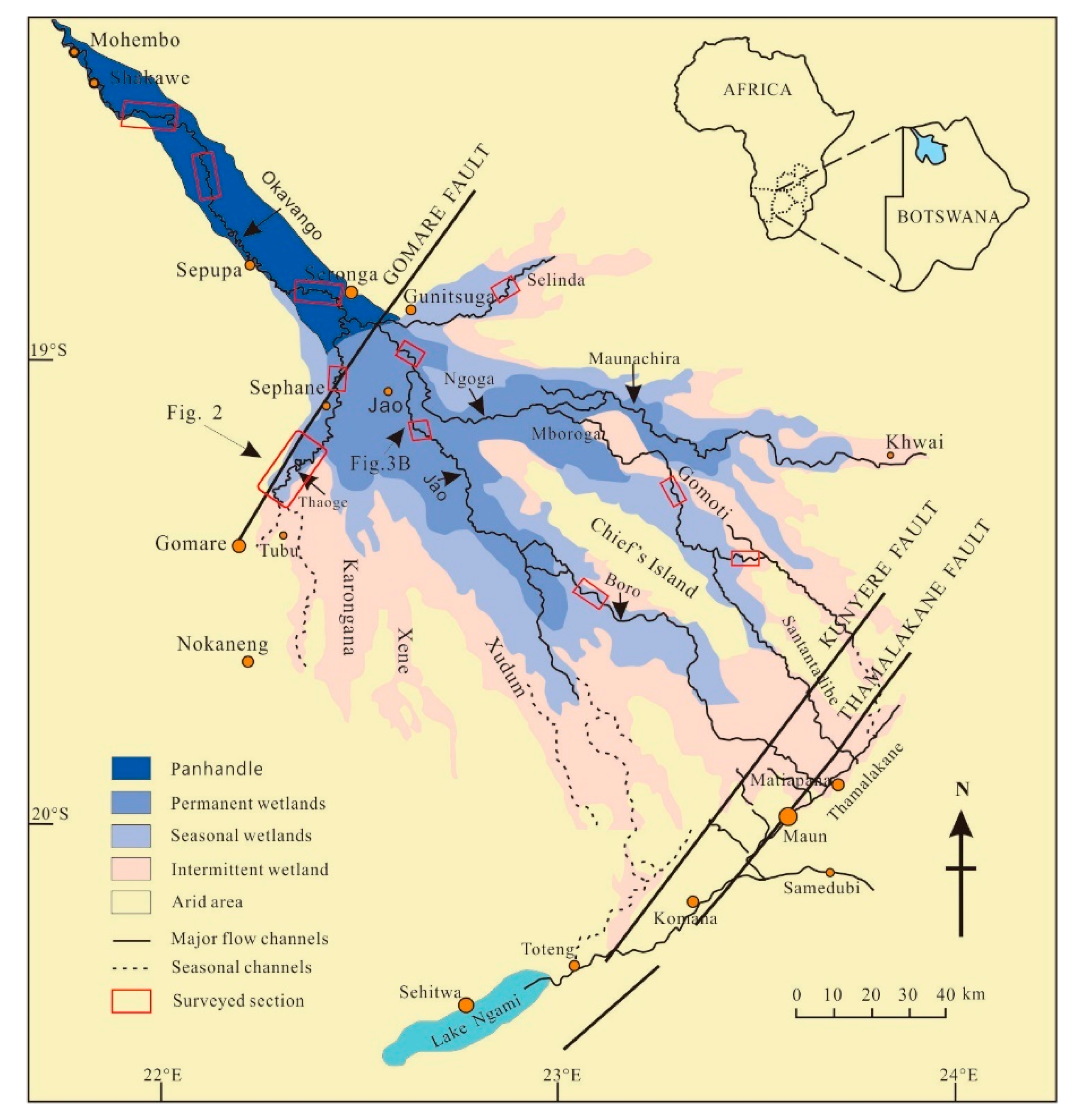
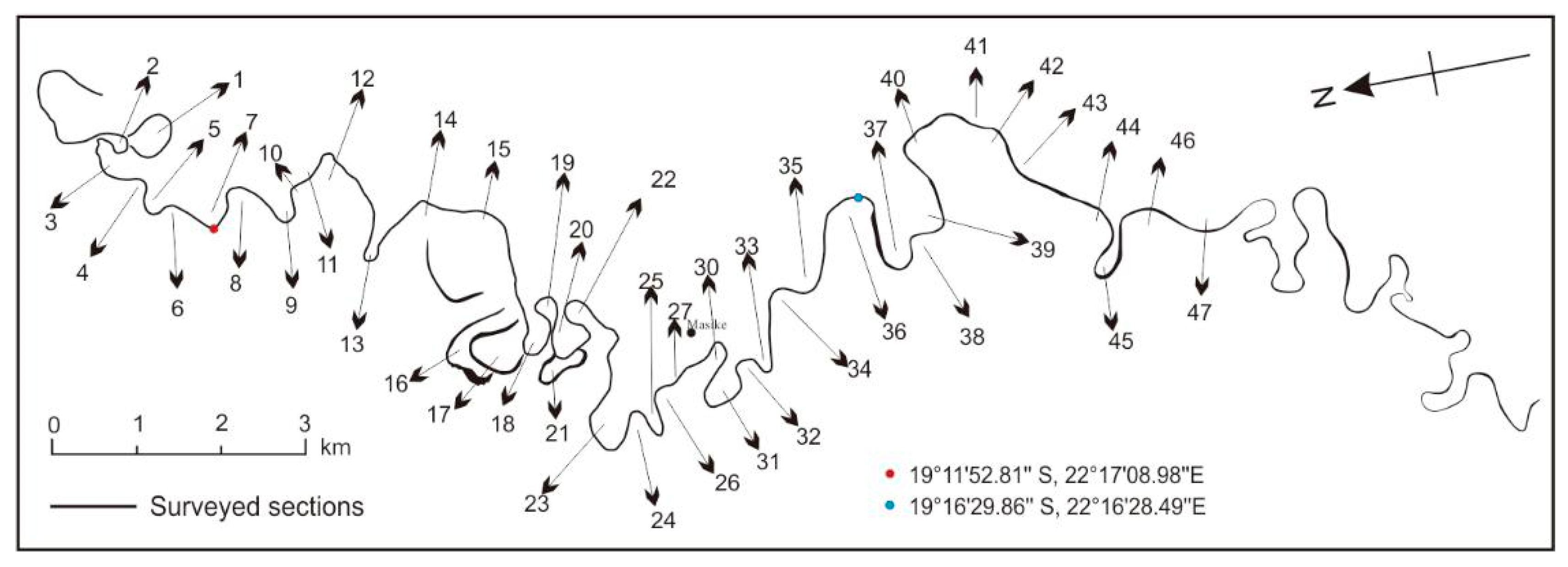

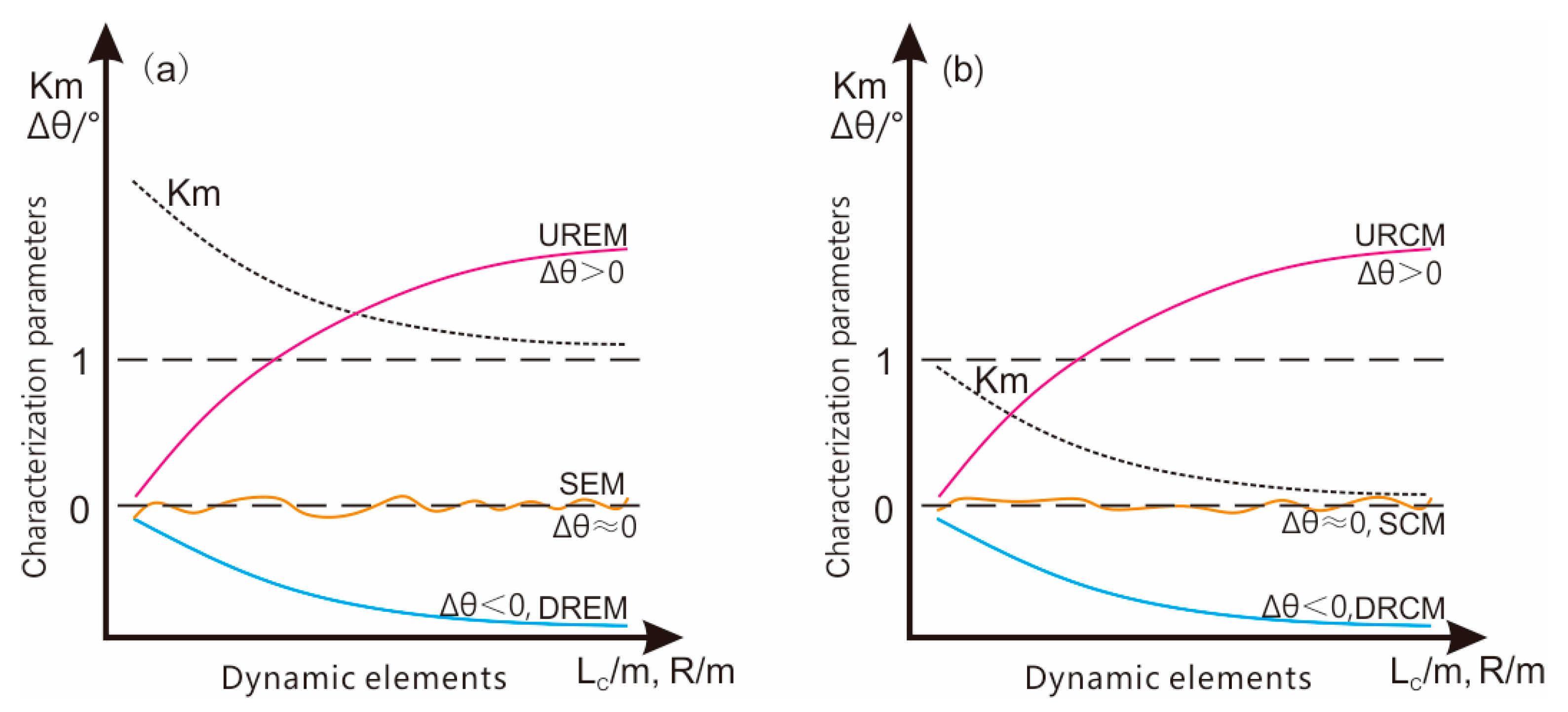

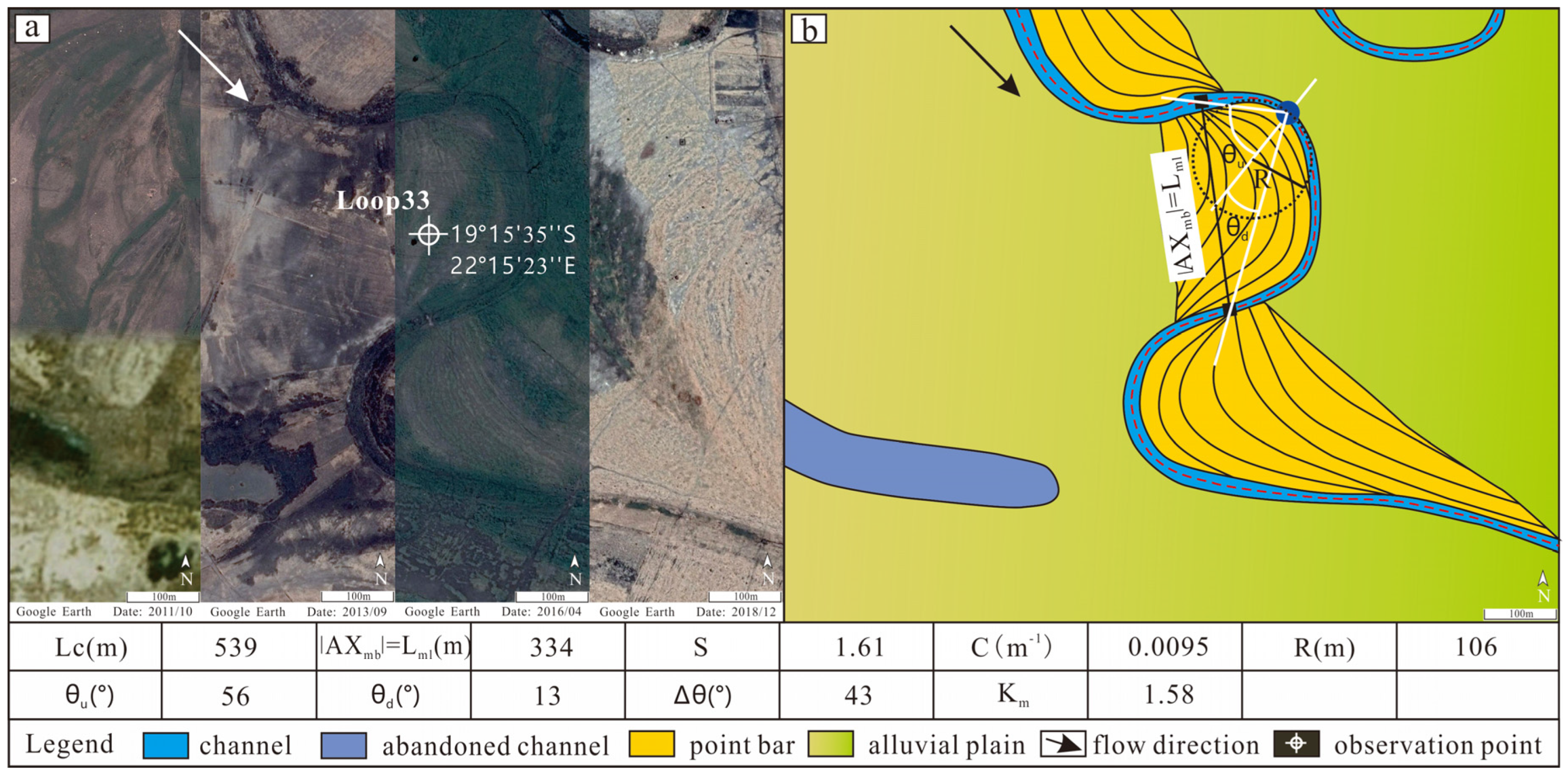
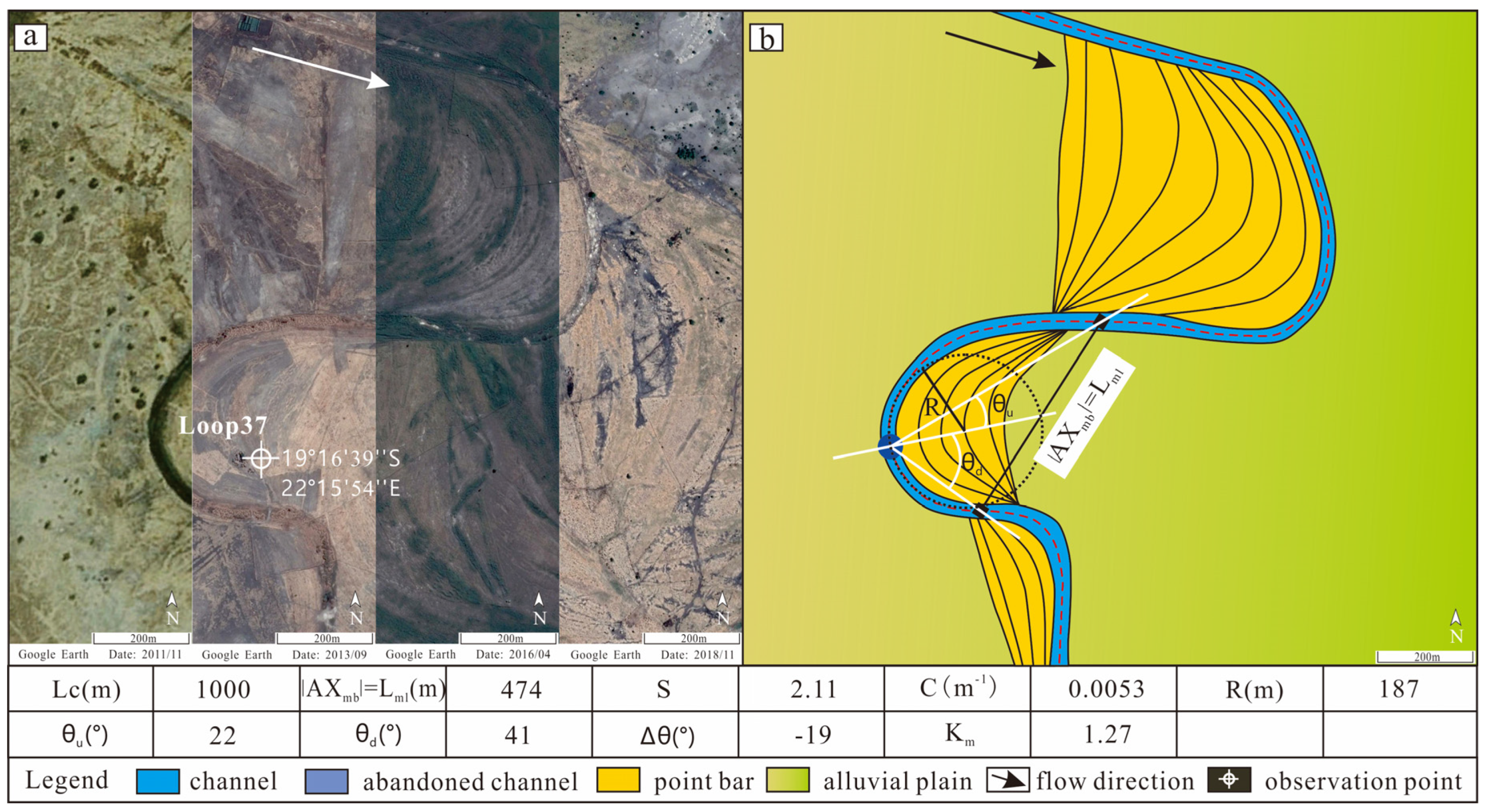

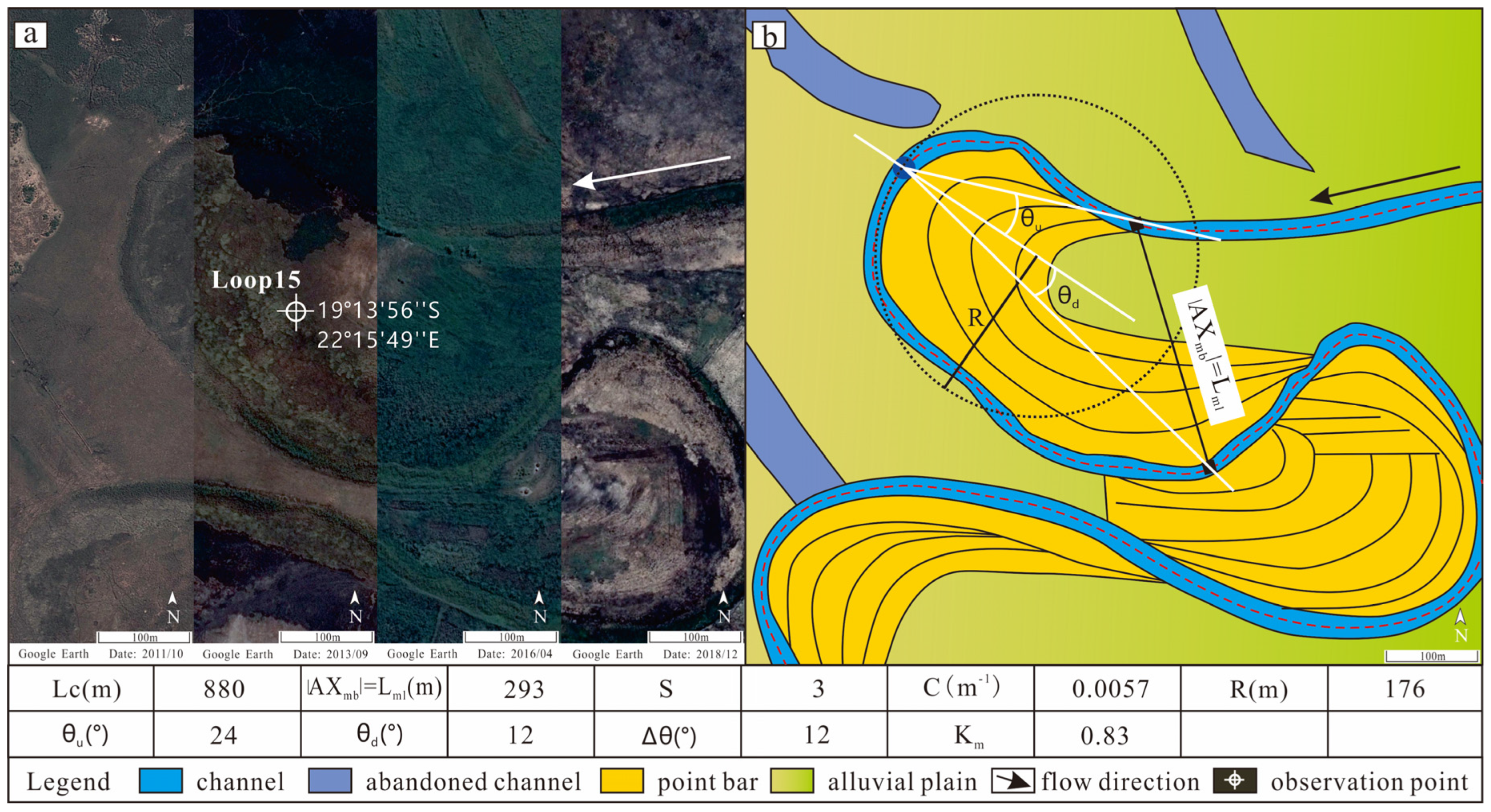
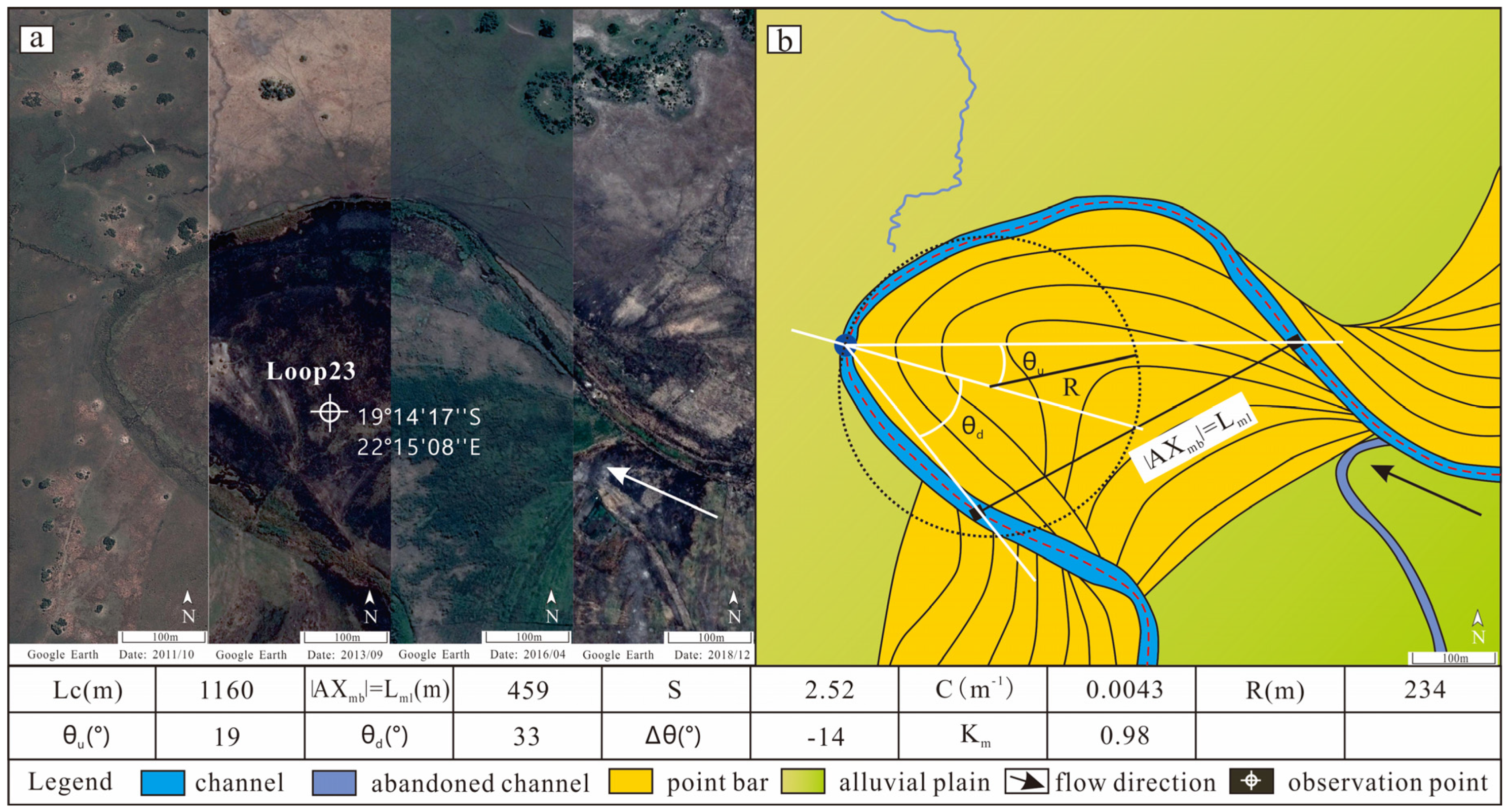
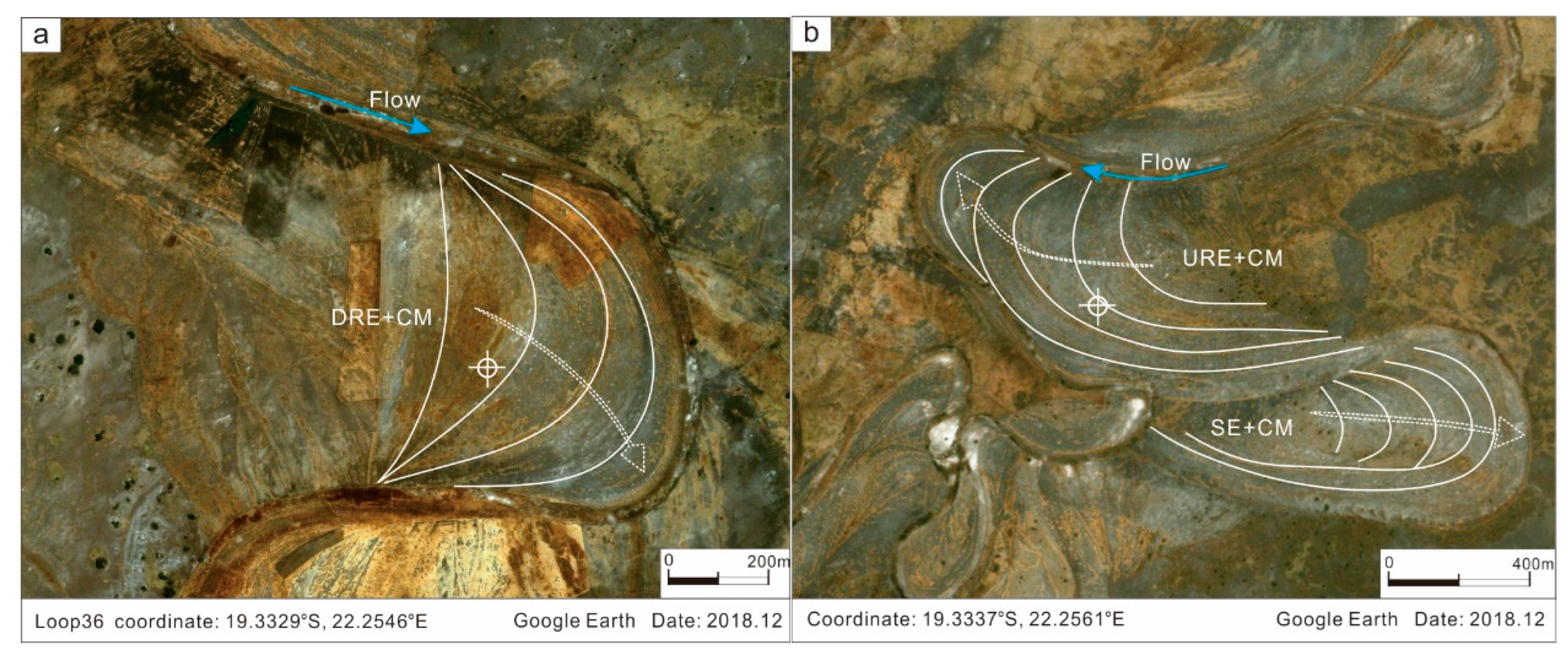
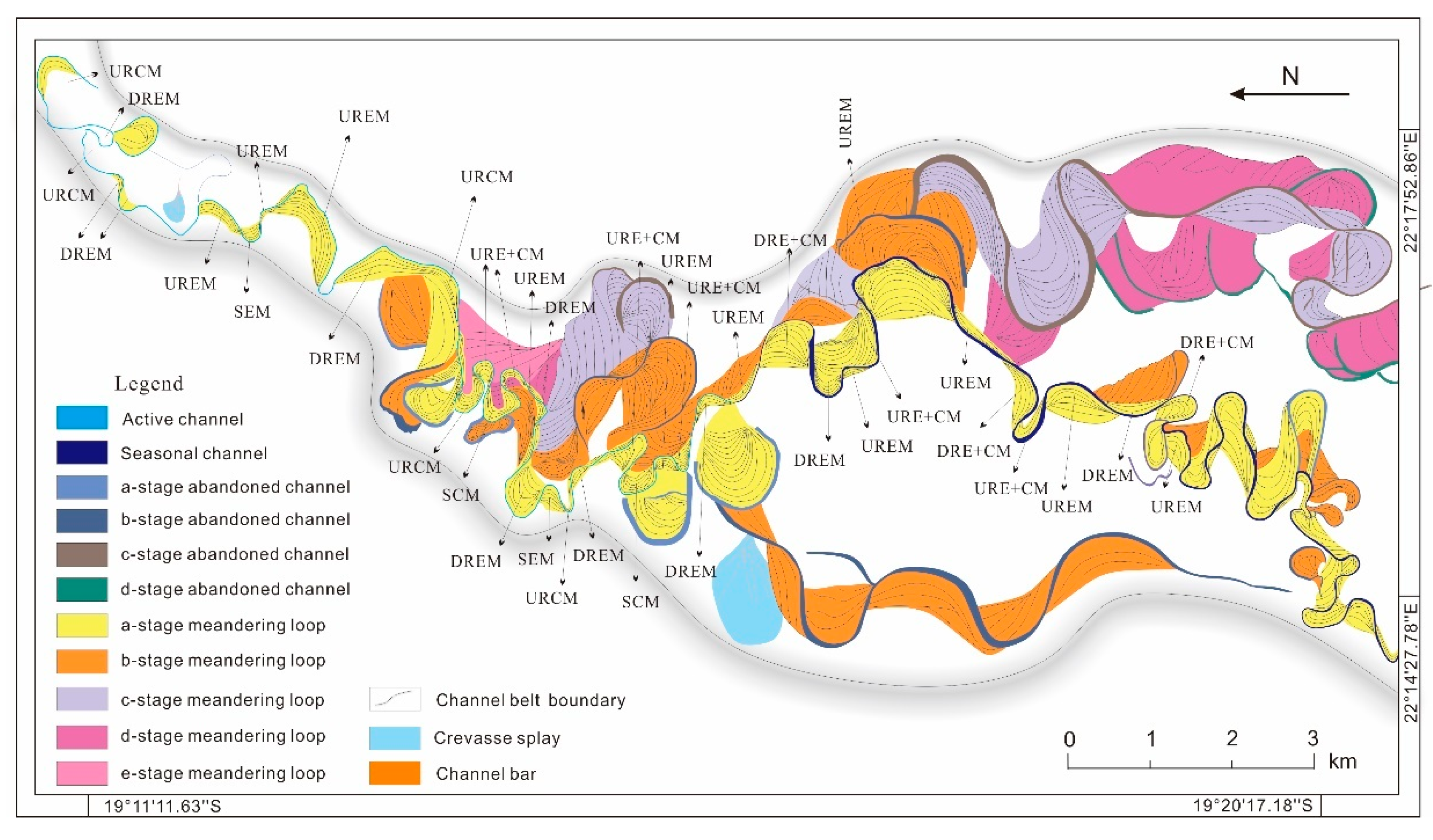
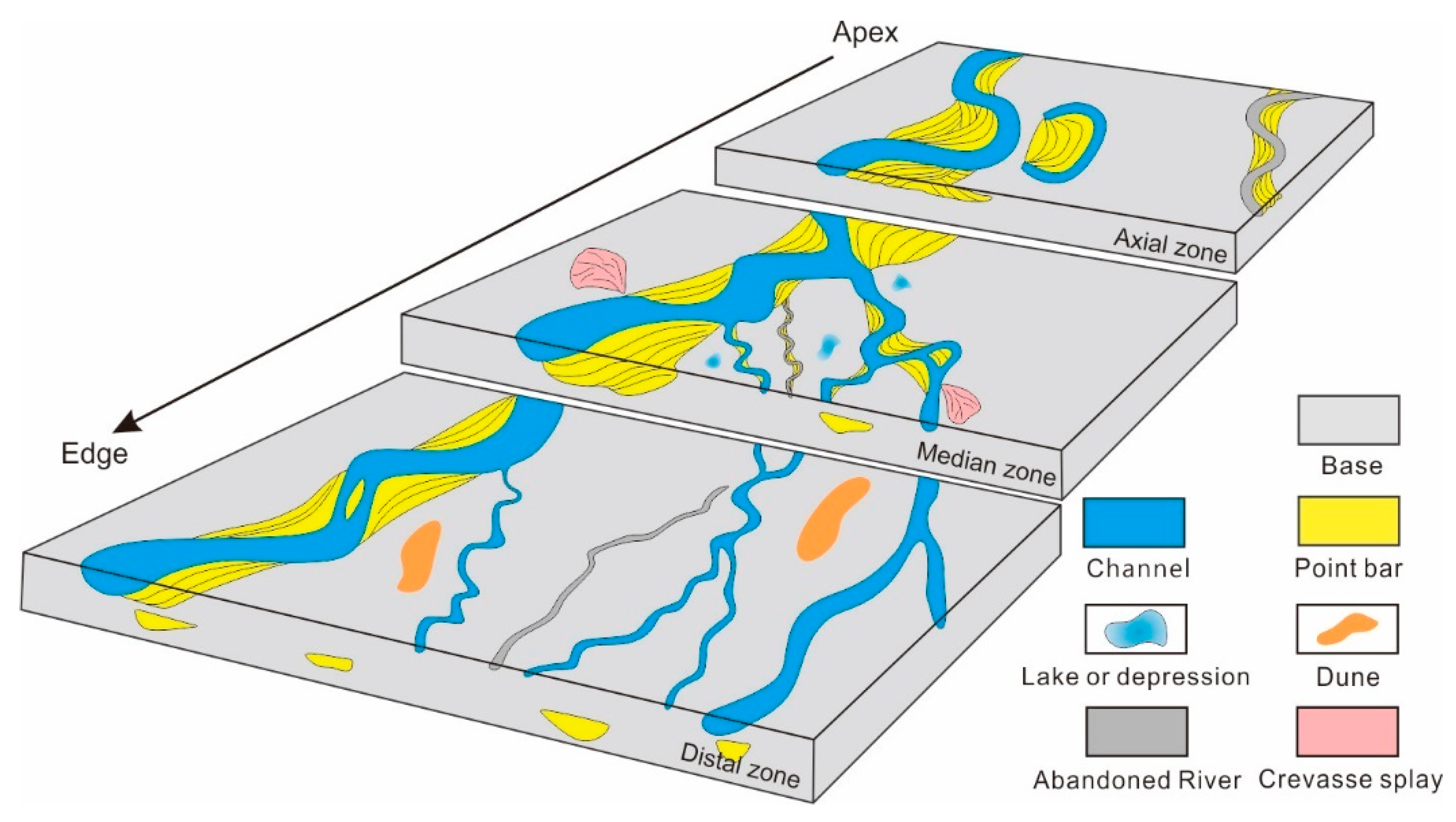
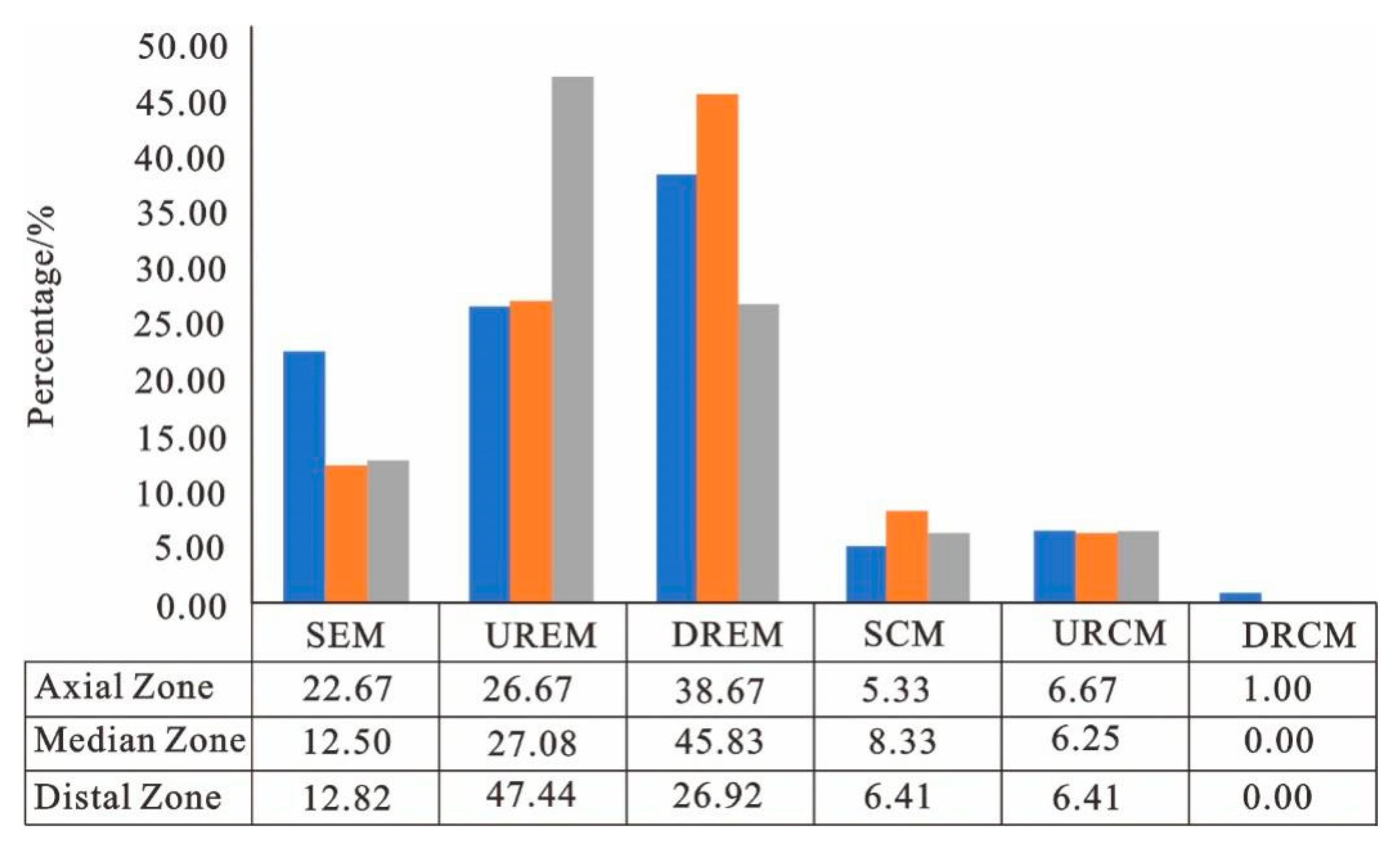
| Loop Units | 5 | 12 | 15 | 17 | 23 | 24 | 31 | 33 | 37 | 46 |
|---|---|---|---|---|---|---|---|---|---|---|
| Latitude | 19°11’25’’ S | 19°12’54’’ S | 19°13’56’’ S | 19°14’15’’ S | 19°14’17’’ S | 19°14’34’’ S | 19°15’13’’ S | 19°15’35’’ S | 19°16’39’’ S | 19°18’02’’ S |
| Accuracy | 22°17’19’’ E | 22°16’41’’ E | 22°15’49’’ E | 22°15’49’’ E | 22°15’08’’ E | 22°15’18’’ E | 22°15’15’’ E | 22°15’23’’ E | 22°15’54’’ E | 22°15’36’’ E |
| Lml (m) | 272 | 138 | 293 | 253 | 459 | 305 | 293 | 334 | 474 | 217 |
| Lc (m) | 410 | 480 | 880 | 1279 | 1160 | 540 | 1148 | 539 | 1000 | 833 |
| R (m) | 71 | 106 | 176 | 181 | 234 | 102 | 232 | 106 | 187 | 205 |
| |AXmb| (m) | 272 | 138 | 293 | 253 | 459 | 305 | 293 | 334 | 474 | 217 |
| AXmb (°) | 227.9 | 225.4 | 162.7 | 196.7 | 235.9 | 181.8 | 200.1 | 138.9 | 207.2 | 183.7 |
| AXml (°) | 303 | 308 | 307 | 256 | 290 | 79 | 315 | 270 | 268 | 319 |
| θu (°) | 34 | 18 | 24 | 15 | 19 | 38 | 21 | 56 | 22 | 13 |
| θd (°) | 55 | 19 | 12 | 21 | 33 | 33 | 16 | 13 | 41 | 9 |
| S | 1.51 | 3.49 | 3.00 | 5.06 | 2.52 | 1.77 | 3.91 | 1.61 | 2.11 | 3.84 |
| C | 0.0142 | 0.0094 | 0.0057 | 0.0055 | 0.0043 | 0.0098 | 0.0043 | 0.0095 | 0.0053 | 0.0049 |
| Δθ (°) | −21 | −1 | 12 | −6 | −14 | 5 | 5 | 43 | −19 | 4 |
| Km | 1.92 | 0.65 | 0.83 | 0.70 | 0.98 | 1.49 | 0.63 | 1.58 | 1.27 | 0.53 |
| Zone | S | C | Δθ(°) | Km | Q (m3/sec) |
|---|---|---|---|---|---|
| Axial zone | 1.91 | 0.01 | −56–53 | 1.69 | 313 |
| Median zone | 1.86 | 0.02 | −57–45 | 1.83 | 102 |
| Distal zone | 1.60 | 0.02 | −64–54 | 2.17 | 35 |
Publisher’s Note: MDPI stays neutral with regard to jurisdictional claims in published maps and institutional affiliations. |
© 2021 by the authors. Licensee MDPI, Basel, Switzerland. This article is an open access article distributed under the terms and conditions of the Creative Commons Attribution (CC BY) license (https://creativecommons.org/licenses/by/4.0/).
Share and Cite
Yan, X.; Zhang, J.; Li, Y.; Sun, L. Channel Migration of the Meandering River Fan: A Case Study of the Okavango Delta. Water 2021, 13, 3319. https://doi.org/10.3390/w13233319
Yan X, Zhang J, Li Y, Sun L. Channel Migration of the Meandering River Fan: A Case Study of the Okavango Delta. Water. 2021; 13(23):3319. https://doi.org/10.3390/w13233319
Chicago/Turabian StyleYan, Xue, Jinliang Zhang, Yang Li, and Long Sun. 2021. "Channel Migration of the Meandering River Fan: A Case Study of the Okavango Delta" Water 13, no. 23: 3319. https://doi.org/10.3390/w13233319





